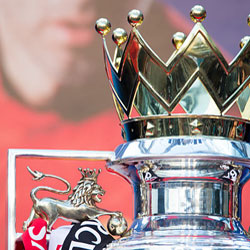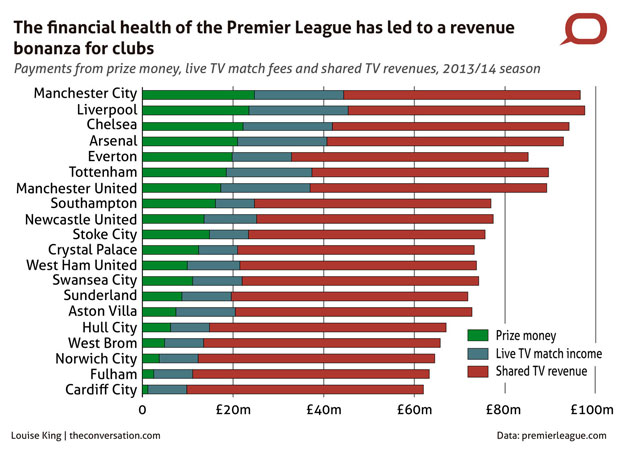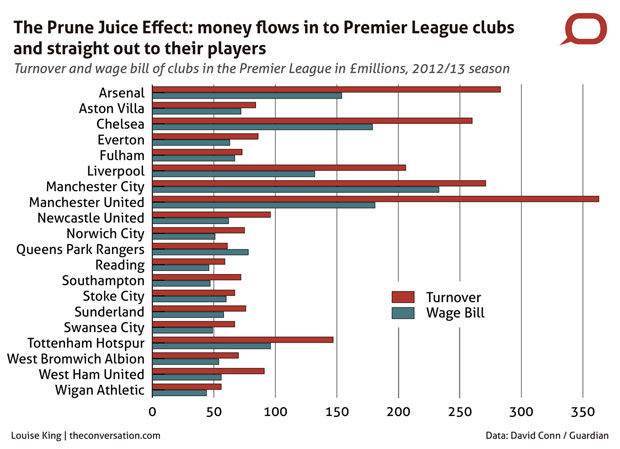
That said, the league can be like Marmite. Some simply cannot survive without a regular ‘fix’; others hate it. Indeed, some argue football was actually better before the Premier League was created in 1992, with all the associated money, hype and global reach. The league today may be rich and powerful – but is it worth it?
A football economy
It is not entirely clear what the total size of the Premier League economy is, but its income tax and national insurance contribution alone is thought to be worth more than £1.3 billion per year to the British government.
Some of the revenues flowing into the game come from places like Abu Dhabi (Sheikh Mansour has spent upwards of £1 billion on Manchester City) and Russia (Roman Abramovich may have spent a similar amount on Chelsea) – important injections into the British economy over the 22 years since the Premier League’s inception.
Yet it is television that has had the most profound effect. Lightning-fast growth has seen domestic broadcast revenues grow from £633,000 per game, when the first deal with BSkyB was struck back in 1992, to £6.53m today.
On top of this, overseas broadcasting rights bring in vast revenues too. For instance, in 2013, NBC in the United States paid US$250m for the right to show Premier League games for three years.
As a result, the league is now broadcast in 212 countries around the world, with a cumulative audience of almost 5 billion people per season. This means that around 70% of the total population of the world’s televised sport market watches Premier League games, while nearly one third of all Premier League viewers are now thought to be in Asia.
Each live Premier League game can have a global audience of more than 12m people, which greatly exceeds viewership of Italy’s Serie A (4.5m), Spain’s La Liga (2.2m), and Germany’s Bundesliga (2m). This popularity is reflected in the sums paid for domestic television contracts: the Premier League’s £3 billion again dwarfing the Serie A (£721m), La Liga (£511m) and Bundesliga (£417.4m) deals.
For Premier League clubs, the financial health of the league has brought a revenue windfall. For example, in the 2013/2014 season, champions Manchester City received payments totalling nearly £98m from the league. Even Cardiff City, who finished the season in last place and were featured on TV the joint-fewest times, said goodbye to top-flight football with almost £64m.

But money received directly from the league only makes up one portion of a club’s income. Global exposure has meant a commercial bonanza and there are now four Premier League clubs in the top ten of Deloitte’s global football money league. This is compared with two from Spain, two from Italy and one each from Germany and France. Forbes ranks Manchester United the third most valuable sports team in the world, at $2.81 billion, just ahead of the New York Yankees.
Cashing in
Inevitably, players who make their way into the Premier League benefit too. Salaries have spiralled upwards to the point where even mediocre players at middling teams are earning several million pounds a year. Last season the likes of Wayne Rooney, Robin van Persie, Yaya Toure and Sergio Aguero all reportedly earned more than £200,000 each week.
Such salaries buy a lot of sports cars and fancy meals in Merseyside and Manchester, important injections into the local economies of the towns and cities where Premier League clubs are located.
Yet it is not just the Premier League, its clubs and their players who benefit. In 2012, Visit Britain claimed that around 900,000 tourists had attended a football game during visits to Britain in the previous year, 40% of them coming simply to watch football. While here, it is estimated that the football tourists spent £706m, or the equivalent of £785 per fan – which is £200 more than an average visitor to Britain normally spends.
This is not just a national-level phenomenon either, it has a tangible impact upon the towns and cities where Premier League clubs are located. Football contributes upwards of £330 million to the economy of Greater Manchester every year and the city’s two major clubs are thought to have an equivalent advertising value of £100m a year.
And there is a societal benefit too; the Premier League has invested £157m into community activities such as its Creating Chances initiative that works with hospitals, charities and other cultural organisations.
By any standards, surely the Premier League is a roaring success?
The flipside
The mind-boggling sums of money would tend to suggest so. But the league is criticised and derided by critics such as The Guardian’s David Conn and the Sporting Intelligence website for perpetuating greed, sanitising a once-proud social institution, destroying the heart and soul of English football, and creating a football elite that has excluded and alienated too many people.
While the world marvels at the globally televised spectacle the Premier League has become, critics refer to the ‘Prune Juice Effect‘: as the TV money flows in, so it flows out again, most notably on transfer fees and salaries. While the likes of van Persie and Aguero no doubt make some economic contribution to their local area the lasting benefits are questionable. Just how much money leaks out of the UK to other countries is a serious question; after all, people who earn millions tend to have very good accountants.
Former Chelsea and Netherlands player Winston Bogarde still serves as the poster boy for Premier League waste and excess. Reputedly paid £2m a season by the London club, he played just nine times in four years with the Blues and quickly disappeared back to the Netherlands at the end of his contract.

Back in 2000, some commentators warned that ‘wage inflation threatened the future of football’, yet salaries have still continued to rise. When the Premier League began in 1992, the average weekly salary of a player in England was £1,755. By the time Bogarde signed for Chelsea in 2000, this figure had risen to £11,184. Now, the average Premier League salary is £31,000 per week.

Indeed, wages for the league as a whole hit £1.78 billion last season. Worryingly, wages also rose above 70% of club turnover for the first time.
Trickling down?
This level of expenditure has not only fuelled wage and transfer inflation in English football’s top-flight but also further down the country’s league structure. This trickle-down effect has caused severe problems for many of English football’s clubs. Indeed, work carried out by John Beech shows there have been 168 club ‘insolvency events‘ since the league was founded in 1992. If the Premier League is the pinnacle of English football, then there is a very long, unstable and precariously positioned tail.
It is also bitterly ironic that, while Wayne Rooney pulls in £250k per week, Citizens UK has identified that it would take a cleaner 13 years to earn that amount. The attitude of pampering the players and the boardroom and squeezing the rest extends right down even to the internship programmes some clubs have been accused of abusing. In one case, a club advertised a year-long, full-time post – no salary, no expenses, long and unsociable hours, with a need for the successful candidate to use their own car for work purposes.
Priced out
Broadcast revenues may be flooding in, but fans of the Premier League continue to suffer. Ahead of the new season, some clubs have dramatically increased ticket prices. Newly-promoted Queens Park Rangers and Burnley have increased the price of their highest-priced season tickets by 38% and 37% respectively; the cheapest Arsenal season ticket is now £1020.
Overall, ticket prices are up almost 7% this season. This almost keeps track with the 8% increase in player salaries, but is far above the average 2.5% pay rise for UK workers.
So the game is less affordable than ever, and Premier League grounds are increasingly gentrified and greying. Football at the highest level is no longer a spectator sport for the young working classes, and the game is losing touch with its roots.
Even TV isn’t the cheap option it once was. To watch live Premier League matches at home, fans must pay at least £40 per month (or £460 per year). This isn’t just bad for those who can’t afford it, or who chose to put their money elsewhere – it is bad for all of us.
The strong league comes at a cost to the national team too. In 1992, Premier League starting line ups featured just 11 foreigners. Now, they make up 70% of the players. The lack of opportunities for local players has a knock-on effect: following England World Cup debacle, the team has fallen to 20th place in FIFA’s rankings, the lowest position in almost two decades.
So, what’s the Premier League worth? In the same way as consumers and critics might struggle to determine an appropriate measure of value for Marmite, so too will many people struggle to decide whether the league is actually worth it or not.
As you look around when you are next at a Premier League game, the millionaires in front of you and the lesser mortals sat next to you have helped make the league a commercial and global phenomenon. The problem is, those on the field may well be spending their cash in Bogota and Brasilia rather than Birmingham and Bristol. While those sat behind you may be really struggling to justify how much they pay to continue being fans.
![]()
This article first appeared on The Conversation website.




